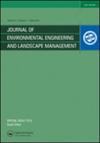APPLICATION NEURAL NETWORK APPROACH FOR THE ESTIMATION OF HEAVY METAL CONCENTRATIONS IN THE INAOUEN WATERSHED
IF 1.1
4区 环境科学与生态学
Q4 ENVIRONMENTAL SCIENCES
Journal of Environmental Engineering and Landscape Management
Pub Date : 2022-12-21
DOI:10.3846/jeelm.2022.18059
引用次数: 0
Abstract
This paper describes how the multilayer perceptron neural network (MLPNN) trained by the Broyden-Fletcher-Goldfarb-Shanno (BFGS) quasi-newton back-propagation approach was used to estimate heavy metal concentrations: Aluminum (Al), Lead (Pb), Copper (Cu), and Iron (Fe), in the province of Taza using sixteen physicochemical factors measured from 100 samples collected from surface water sources by our team, according to the protocol of the national water office (ONE). We chose a network with only one hidden layer to identify the network architecture to employ. The number of neurons in the hidden layer was varied, as were the types of transfer and activation functions, and the BFGS learning method was used. The following statistical metrics were used to evaluate the performance of the neural network’s stochastic models: Examining the adjustment graphs and residue, as well as the Error Sum of Squares (SSE); the mean bias error (MBE) and determination coefficient (R²). The results reveal that the predictive models created using the artificial neural network method (ANN) are quite efficient, thanks to the BFGS algorithm’s efficiency and speed of convergence. An architectural network [16-8-1] (16: number of variables in input layer, 8: number of hidden layer, 1: number of variables in output layer) produced the best results,{R²: Al(0.954), Pb(0.942), Cu(0.921), Fe(0.968)}, {SSE: Al(0.396), Pb(0.0059), Cu(0.252), Fe(4.29)} and {MBE: Al(–0.033), Pb(0.008), Cu(–0.004), Fe(0.091)}, which is developed so that each model is responsible for estimating the concentration of a single heavy metal. This result demonstrates that there is a non-linear relationship between the physical-chemical properties evaluated and the heavy metal content of surface water in the Taza province.应用神经网络方法估算黄河流域重金属浓度
本文描述了如何使用多层感知器神经网络(MLPNN)训练的broyden - fletcherer - goldfarb - shanno (BFGS)准牛顿反向传播方法来估计重金属浓度:铝(Al),铅(Pb),铜(Cu)和铁(Fe),在Taza省使用16个理化因素测量从地表水收集的100个样本,由我们的团队,根据国家水局(ONE)的协议。我们选择了一个只有一个隐藏层的网络来确定要使用的网络架构。隐层神经元数量变化,传递函数和激活函数类型变化,采用BFGS学习方法。使用以下统计指标来评估神经网络随机模型的性能:检查调整图和残差,以及误差平方和(SSE);平均偏置误差(MBE)和决定系数(R²)。结果表明,由于BFGS算法的效率和收敛速度,利用人工神经网络方法(ANN)建立的预测模型是非常有效的。一个架构网络[16-8-1](16:输入层的变量数,8:隐藏层的变量数,1:输出层的变量数)产生了最好的结果,{R²:Al(0.954), Pb(0.942), Cu(0.921), Fe(0.968)}, {SSE: Al(0.396), Pb(0.0059), Cu(0.252), Fe(4.29)}和{MBE: Al(-0.033), Pb(0.008), Cu(-0.004), Fe(0.091)},这使得每个模型都负责估计单一重金属的浓度。结果表明,塔扎省地表水的理化性质与重金属含量之间存在非线性关系。
本文章由计算机程序翻译,如有差异,请以英文原文为准。
求助全文
约1分钟内获得全文
求助全文
来源期刊
CiteScore
1.90
自引率
7.70%
发文量
41
审稿时长
>12 weeks
期刊介绍:
The Journal of Environmental Engineering and Landscape Management publishes original research about the environment with emphasis on sustainability.

 求助内容:
求助内容: 应助结果提醒方式:
应助结果提醒方式:


